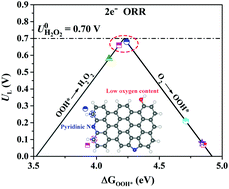Nitrogen and oxygen tailoring of a solid carbon active site for two-electron selectivity electrocatalysis†
Abstract
The synthesis of hydrogen peroxide (H2O2) via two-electron (2e−) oxygen reduction reaction (ORR) electrocatalysis has garnered extensive attention as an appealing green and safe production technology. However, the key progress is still strongly dependent on developing highly active, selective and stable electrocatalysts. Here, guided by first-principles calculations, we developed a rational design for nitrogen (N) and oxygen (O) tailoring of carbon materials by precisely controlling the pyridinic N (Pydn-N) structure and the oxygen doping. The second nearest C atoms of Pydn-N were identified to be the active site, and this is suppressed owing to its local chemical environment and increase in the oxygen dopant content. Experimentally, high-temperature hydrogenation (HTH) regulates the Pydn-N content and synchronous oxygen removal for N,O co-doped carbons (CNO-x). The increment of Pydn-N from 37.42% up to 39.73%, along with oxygen removal from 5.24 at% down to 3.80 at% after HTH, promotes the H2O2 selectivity and electron transfer number (n) to 82% and 2.36. The H2O2 production rate is stable at around 200 mmol gcat−1 h−1 and a faradaic efficiency (F.E.) of up to 80% was recorded during the initial 4 h. The long-term H2O2 production further highlights the significance of sustaining the Pydn-N structure, modulating the solid carbon active site.



 Please wait while we load your content...
Please wait while we load your content...